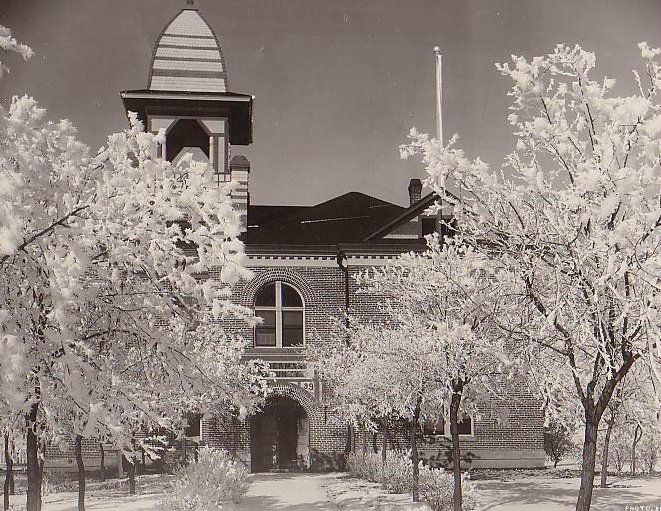“The settlers on the Sherman County hills developed an independent streak shortly after getting located … The spirit of independence… ownership of land… led to a desire to have a new county all of their own.” — ~ Giles French
See: Our County is Formed by Patty Moore
Sherman County: For The Record, vol. 1, no. 2, 1983 & other stories in Sherman County: For The Record 1983-2015.
February 25th!
Happy Birthday, Sherman County!
IMAGINE!
Imagine the history and the stories of our handsome historic county courthouse! Imagine the pride, anguish, trials, joy, excitement and frustration of the years…of public service, justice, weddings, mortgages, deeds, county business transactions.
A BIT CURIOUS!
It is a bit curious that, while Sherman County was carved from Wasco County in 1889, the courthouse was not built until ten years later. E. O. McCoy petitioned the legislature for formation of the new county in 1889, proposing to name it Fulton County for Col. James Fulton, a prominent pioneer legislator. In a political move because Col. Fulton opposed a visit to the state house by General William Tecumseh Sherman, the new county was named Sherman. Governor Sylvester Pennoyer signed the modified bill on February 25, 1889, and the new county was named for General Sherman.
OFFICIALS
The governor appointed officers to serve the county until the next general election: Col. James Fulton, county judge, [who declined, and Owen M. Scott was appointed]; John Medler and Dayton Elliott, commissioners; V.C. Brock, clerk; E.M. Leslie, sheriff; Levi Armsworthy, treasurer; C.C. Meyers, assessor; and C.J. Bright, school superintendent. On March 12, 1889, the newly-appointed officers and constituents met at the Oskaloosa Hotel in Wasco for the official swearing-in. Wasco was declared the temporary county seat. The new officials rented a rock and concrete building in Block 6 on Lot 7 in Wasco to be used by the sheriff and clerk. County and circuit court business was conducted in the school building.
EXPANSION
During the 1891 Oregon legislative session, a bill was introduced to expand the county 18 miles south, taking in Townships 3, 4 and 5 South. This new boundary followed Buck Hollow and an 11-mile east-west boundary across the south.
COUNTY SEAT
Selection of a county seat resumed in earnest. Three towns were selected for the ballot: Wasco, Moro and Kenneth [a hamlet once located near DeMoss Springs]. Strong emotions led up to the vote for Moro, influenced by the county’s southward expansion and new residents. In 1892 the county contracted for construction of a temporary building to house the clerk, sheriff and a vault. Records were moved to Moro. In 1893 a jail was added and the vault was rebuilt. A flag pole and flag were ordered in 1895. In 1896, a deputy clerk and deputy sheriff were hired.
1899
When the county began construction of the new courthouse on Block 23 in 1899, the temporary house on Block 23 in Moro was moved across the street to the south where it remains today. Charles Burggraf of Salem designed the handsome brick structure with Queen Anne architectural features, varied wall surfaces and a corner tower. It was built by contractor, A.F. Peterson of Corvallis, of thrifty material – brick manufactured in the brick yard behind it. The bell-shaped cupola was originally painted alternating bands of dark and light paint.
FOR THE RECORD
In a story written by Patricia [French] Moore and published in Sherman County: For The Record in 1983, it is noted that the Grass Valley Journal reported completion of the new courthouse on November 3rd. On the 10th the Journal editor observed that, “Everyone who has seen the new courthouse wonders how such a house could have been built with so little money [$6,665]. On November 22nd, 1899, Sherman County’s handsome, new courthouse was turned over to county officials.”
PROGRESS
In 1905, the Observer reported that there was a pot-bellied stove in each office and a complex of chimneys in the attic. Will Raymond was commissioned to produce ten large photographs of Sherman County scenes for the county’s exhibit at the Lewis and Clark Exposition in Portland and later for the courthouse walls, where they may be seen today. A jail and related supplies were purchased for $3,847 in 1905 and was located in the room the assessor now occupies. The assessor worked in the front room next to the clerk’s office.
CHANGE
Moore’s story continues. “Major changes took place in 1934…the decision to dig a basement, construct walls, install a furnace and chimney for central heat and to put in a vault…work done as a relief project…under the leadership of county engineer, Hal White.” In 1941, the clerk’s vault was extended and the jail was moved to the rear of the courthouse. The brick on the south wall shows evidence of this move and brick replacement with matching windows. Upstairs remodeling accompanied construction over the jail, with chambers for the judge and jury. The handsome cupola was removed because of wind and storm damage by 1963 when Lee Gunnels painted the courthouse trim.
MORE CHANGE
Modern carpeting, tile ceilings, computers and glass doors joined delicate wooden ornamentation, filigree knobs and round-topped windows. The white picket fence is long gone; the jail is a museum artifact. New sidewalks and landscaping in 1999 marked the 100th anniversary of the county’s seat of government.
~ The Sherman County Centennial Committee, 1989.

